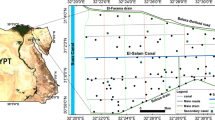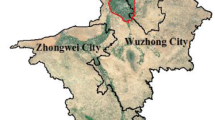Abstract
Derivative spectroscopy is a powerful mathematical tool that provides more useful information of spectral data than untreated data. Visible and near-infrared diffuse reflectance spectroscopy (VIS-NIR) has shown levels of accuracy comparable to conventional laboratory methods for estimating soil properties. The VIS-NIR spectrum is one of the most important data acquisition technologies for digital soil mapping, precision agriculture, and soil resource surveys. The objective of this study was to develop a soil salt content model using the fractional-order derivatives of field-measured spectral data paired with ground measurements. The results showed the following: There was a significant correlation between the single-band reflectance spectra and the soil salt content, and as the derivative order increased, reflectance values first increased and then decreased, with a peak value, R = 0.525, in the 1.2-order derivative. Strong correlations between the estimation of soil salt content and the derivative spectral data of the difference index (DI), ratio index (RI), and normalized difference index (NDI) were also produced by the 1.2-order derivative. R values for the DI, RI, and NDI were 0.818, 0.8624, and 0.8297, respectively. Selected bands with the highest correlation values from the 1.2-order derivative spectral data of the R1428, DI (R1426 / R2151), RI (R1429 − R2024), and NDI (R1526 − R2470)/(R1526 + R2470)] were used to build a model to estimate soil salt content, which showed an R2 value of 0.53 and low RMSE and SD values. The 15 samples of the data were then used to validate the single-band model, R1428, and the combination models, DI (R1426 / R2151), RI (R1429 − R2024), and NDI [(R1526 − R2470)/(R1526 + R2470)], which demonstrated that the R2 values were greater than 0.8. The RMSE and SD values were low, and the value of the RPD was greater than 1.4. This study demonstrated the potential of using fractional derivatives rather than integer derivatives for soil salt content estimation. By making full use of hyperspectral data, fractional derivatives could enrich data preprocessing methods and unearth information about spectral emissions that are lost by integer derivatives. Although this study is a straightforward application of the fractional derivative method, it provides a reference for the estimation of other parameters with hyperspectral technology.






Similar content being viewed by others
References
K. Baderia, A. Kumar, G.K. Singh, Hybrid method for designing digital FIR filters based on fractional derivative constraints. ISA. Trans. 58, 493–508 (2015)
V. de Paul Obade, L. Rattan, Assessing land cover and soil quality by remote sensing and geographical information systems (GIS). Catena 104, 77–92 (2013)
J.L. Ding, D.L. Yu, Monitoring and evaluating spatial variability of soil salinity in dry and wetseasons in the Werigan-Kuqa Oasis, China, using remote sensing and electromagnetic induction instruments. Geoderma 2014, 316–322 (2014)
A. El Harti, R. Lhissoua, K. Chokmani, et al., Spatiotemporal monitoring of soil salinization in irrigated Tadla plain (Morocco) using satellite spectral indices. Int. J. Appl. Earth Obs. Geoinf. 50, 64–73 (2016)
Y.C. Gao, J.N. Wang, S.H. Guo, Y.L. Hua, T.T. Li, et al., Effects of salinization and crude oil contamination on soil bacterial community structure in the Yellow River Delta region, China. Appl. Soil Ecol. 86, 165–173 (2015)
R. Gerbbers, V.I. Adamchuk, Precision agriculture and food security. Science 327, 828–831 (2010)
Hamzeh, A.A. Naseri, Behzad, S.K. Alavi Panah, Estimating salinity stress in sugarcane fields with spaceborne; hyperspectral vegetation indices. Int. J. Appl. Earth Obs. Geoinf. 21(1), 282–290 (2013)
A. Harti, R. Lhissou, K. Chokmani, Spatiotemporal monitoring of soil salinization in irrigated Tadla ain (Morocco) using satellite spectral indices. Int. J. Appl. Earth Obs. Geoinf. 2016(50), 64–73 (2016)
W. Ji, Z. Shi, Q. Zhou, L.Q. Zhou, VIS-NIR reflectance spectroscopy of the organic matter in several types of soil. J. Infrared Millim Waves 31(3), 277–282 (2012) (In Chinese)
Jin X L, Du J, Liu H J, Wang Z M, Song K S, Remote estimation of soil organic matter content in the Sanjiang Plain, Northest China: The optimal band algorithm versus the GRA-ANN model. Agric For Meteorol 218–219, 250–260 (2006)
Z.X. Leng, L.M. Ge, X.L. Nurbey Pan, Functional district of Ebinur Lake watershed based on GIS. South North Water Transf. Water Sci. Technol. 4(1), 33–35 (2006)
Y. Li, H. Tang, H. Chen, Fractional-order derivative spectroscopy for resolving simulated overlapped Lorenztian peaks. Chemom. Intell. Lab. Syst. 107, 83–89 (2011)
J. Li, L. Pu, M. Zhu, R. Zhang, The present situation and hot issues in the salt-affected soil research. Act Geograph. Sin. 67(9), 1233–1245 (2012) (In Chinese)
X. Li, Y. Zhang, Y. Bao, Exploring the best hyperspectral features for LAI estimation using partial least squares regression. Remote. Sens. 6, 6221–6241 (2014)
H.M. Ozaktas, B. Barshan, D. Mendlovic, Convolution and filtering in fractional Fourier domains. Opt. Rev. 1(1), 15–16 (1994)
Y.I. Pankova, A.F. Novikova, A. Kontoboytseva, in Developments in Soil Salinity Assessment and Reclamation, ed. by S. A. Shahid, M. A. Abdelfattah, F. K. Taha. The new map of soil salinity and regularities in distribution of salt-affected soils in Russia (Springer-Verlag, Berlin, 2013), pp. 99–111
J. Peng, H. Liu, Z. Shi, Regional heterogeneity of hyperspectral characteristics of salt-affected soil and salinity inversion. Trans. Chin. Soc. Agric. Eng. 30(17), 167–174 (2014) (In Chinese)
V. Poenaru, A. Badea, S.M. Cimpeanu, Multi-temporal multi-spectral and radar remote sensing for agricultural monitoring in the Braila plain. Agric. Agric. Sci. Proscenia 6, 506–516 (2015)
Y. Pu, W. Wang, J. Zhou, Y. Wang, H. Jia, Fractional differential approach to detecting textural features of digital image and its fractional differential filter implementation, Science in China. Series F. Inf. Sci. 51(9), 1319–1339 (2009)
F. Rui, Z. Yushu, W. Yu, Analysis of the relationship between the spectral characteristics of maize canopy and leaf area index under drought stress. Acta Ecol. Sin. 33, 301–307 (2013)
P.A. Sanchez, S. Ahamed, F. Carre, et al., Digital soil map of the world. Science 325, 680–681 (2009)
E. Scudiero, T.H. Skaggs, L. Dennis, Corwin. Comparative regional-scale soil salinity assessment with near-ground apparent electrical conductivity and remote sensing canopy reflectance. Ecol. Indic. 2016(70), 276–284 (2016)
V.E. Tarasov, On chain rule for fractional derivatives communications in. Nonlinear Sci. Num. Simul. 30(1), 1–4 (2016)
S. Tonglu, L. Jianjun, H. Zhi, Tunable continuous-wave terahertz radiation system based on photomixing. Chin. J. Lasers. 41(4), 0411001 (2014)
X. Wang, F. Zhang, K. Hsiang-Te, H. Yu, Spectral response characteristics and identification of typical plant species in Ebinur lake wetland national nature reserve (ELWNNR) under a water and salinity gradient. Ecol. Indic. 81, 222–234 (2017)
J. Xu, F. Xinlu, G. Liang, et al., Fractional differential application in preprocessing infrared spectral data. Control Instrum. Chem. Ind. 39(3), 347–351 (2012)
I. Yahiaoui, A. Douaoui, Q. Zhang, A. Ziane, Soil salinity prediction in the lower Cheliff plain (Algeria) based on remote sensing and topographic feature analysis. J. Arid. Land 7, 794–805 (2015)
G. Yang, L. Lu, C. He, et al., Baseline correction method for Raman spectra based on generalized Whittaker smoother. Chin. J. Lasers. 42(9), 0915003 (2015)
F. Zhang, T. Tashpolat, V.C. Johnson, H. Kung, Evaluation of land desertification from 1990 to 2010 and its causes in Ebinur Lake region, Xinjiang China. Environ. Earth Sci. 73, 5731–5745 (2015)
B. C. O’Kelly, Accurate determination of moisture content of organic soils using the oven drying method. Drying Technology 22(7), 1767–1776 (2004)
Acknowledgments
The authors wish to thank the referees for providing helpful suggestions to improve this manuscript. The authors wish to thank Professor Abduwasit Ghulam (Saint Louis University) have helped us to improve the manuscript carefully. Please see the revised version of the paper.
Funding
The research was carried out with the financial support provided by the Xinjiang Local Outstanding Young Talent Cultivation Project of National Natural Science Foundation of China (U1503302).
Author information
Authors and Affiliations
Corresponding author
Rights and permissions
About this article
Cite this article
Zhang, F., Wang, X., Kung, Ht. et al. Estimating Soil Salt Content Using Fractional Derivatives and Optional Spectral Indices in the Ebinur Lake Oasis, Northwestern China. Data-Enabled Discov. Appl. 2, 6 (2018). https://doi.org/10.1007/s41688-018-0017-2
Received:
Accepted:
Published:
DOI: https://doi.org/10.1007/s41688-018-0017-2




